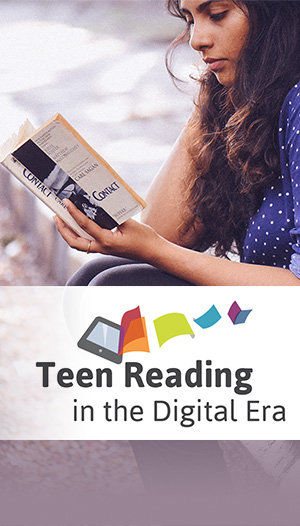Printed books still draw youth in the digital era
Research news
Despite being a tech-savvy generation, research finds that adolescents still prefer print books.
Data from a collaborative one-year pilot study between Deakin and Murdoch Universities has uncovered some surprising findings about the recreational reading habits of teenagers.
“We found that digital platforms are not very motivating. Both regular readers and reluctant readers agreed that paper books are preferred, as they find them more engaging,” said lead researcher Dr Leonie Rutherford, a senior lecturer in writing and literature with Deakin University’s School of Communication and Creative Arts.
The interdisciplinary team of seven researchers focussed on how and where print books, eBooks and other long-form digital texts (2000+ words) were accessed by 550 adolescents aged 10-18, from Victoria and Western Australia.
The data showed that 70 per cent of participants read at least weekly for pleasure and 50 per cent read for at least 15 minutes each day.
The study also uncovered factors that may influence reading material decisions, in addition to age, gender, parents’ education level, and place of residence.
“Research shows there is an association between reading for pleasure, achievement in school subjects, and post-school vocational outcomes, regardless of family socio-economic positioning and education level. So we need to find out how to motivate recreational reading,” Dr Rutherford said.
The research is informing discussions with book industry professionals and educators around Australia, with data from the pilot study presented to stakeholders at a symposium late last year.
Stakeholders included members of the State Libraries of Victoria, Western Australia and the Northern Territory; the Australian Publishers’ Association; the Australian Booksellers’ Association; the Australian Association of Teaching of English; School Libraries’ Association; the Commissioner for Children and Young People; the Australian Library and Information Association; and the Victorian and Western Australian State Departments of Education.
“Key themes that we discussed at the symposium included: the finding that attendance of book-related events didn’t prove influential for increasing readership; that adolescence is a key period for establishing social habits like reading for maintenance in adult life; and that family was quite instrumental in reading behaviour, both via habits and availability of texts in the home,” Dr Rutherford said.
“We also talked about the need for others to have read the same book to encourage discussions with peers and family.”
Dr Rutherford said the reading culture surrounding young people influences their motivation to read. That means role modelling and support for school libraries, in terms of building the collection and integrating use of the service, could have a significant impact on the reading habits of young people.
“Finding a text they can relate to appears to be motivating, and builds engagement and reading behaviour,” she added.
“Our data indicated a key reason why teens were not reading was because of difficulty choosing what to read.”
The top ten favourite books or series list uncovered another trend in the data, as it was predominantly filled by titles with media tie-ins.
Dr Rutherford said it was unclear in all cases whether those titles were popular primarily because of the game or movie they related to, since the guaranteed audience of an already popular series frequently paved the way for a subsequent media franchise.
While the study didn’t specifically address social media, participant interviews revealed recurring references to use of Wattpad, a free, participatory writing site and app.
The data also found that a lesser proportion of young people read eBooks on a smart device, compared with a dedicated eReader, despite around 90 per cent of the sample having access to a tablet, desktop, laptop or mobile, while only 24 per cent have access to an eReader.
“This may be due to the distraction that comes from reading on a multipurpose device,” Dr Rutherford said.
“eBooks are also more difficult to read on some platforms, compared to others, and that’s crucial for stakeholders to know.
“Formats of downloads may dictate what you can borrow online. For example, in Australia you can’t borrow eBooks in the ePublishing format that Kindles use via our public libraries. Digital literacy is required if you want to access a book that is not in the recommended format, and that can become a barrier.”
Dr Rutherford said the pilot study had allowed researchers to develop a robust collection of methodologies for future research.
“We hope to build on the pilot study by gathering further, comprehensive data from 2000-3000 Year 7 to 12 students from every state in Australia to indicate trends that more broadly represent Australian teen reading.”
For all media enquiries please contact Deakin’s media team.
Share this story

Key Fact
“Our data indicated a key reason why teens were not reading was because of difficulty choosing what to read.”
